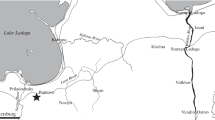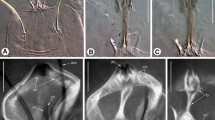Summary
The irregular Clypeastroida include both species with highly ovate tests, high lanterns and arched, nearly vertical located teeth, and species with flattened tests and straightened, slender and horizontal orientated teeth. Irrespective of form and orientation of the teeth the tooth-elements of Clypeastroida, are built up following the same construction (Fig. 1). The tooth is devided by the small abaxial (ab) and the large adaxial (ad) tooth part. The adaxial part consists of prisms (P) and of lateral plates (LP).
In Clypeastroids the teeth do not protruded out of the mouth. They are used for chewing but not for feeding. Echinoid teeth are built of calcite, but they are considerable stronger than compact calcite. The tooth of Fellaster zelandiae demonstrates that it is the true tooth, built up as composite material, which is extreme hard. The calcareous appendage of polycristalline calcite is only as hard as compact calcite. In chewing the clypeastroid teeth are exposed to compressive stress only, which acts in the axis of the teeth. The chewing area in most species is built up both by prisms and by lateral plates. But in some species it is built up by prisms only (Dendraster, Mellita) and in other species by lateral plates only (Fellaster, Echinodiwus). The Vickers-hardness (HV) of the teeth is not influenced by these differences.
The suborders given by Durham (1955) are discussed and accepted. But the Rotulidae-despite some aberrant properties-are proposed to be classified into the suborder Laganina by means of the structure of their teeth and other characters.
The present work verifies the formerly expressed opinion that Clypeastroida are belonging to a monophyletic group of their own, which is considered to be a sister group of the recent regular echinoids. On the basis of morphological studies the Clypeastroida-contrary to the hypothesis of Durham and Melville (1957)-are said to be not derivable from cidaroid ancestors or descendants of cidaroid ancestors.
Zusammenfassung
Zu den irregulären Clypeastroida gehören einerseits hochgewölbte Arten, mit hohen Laternen and gekrümmten, steil stehenden Zähnen, andererseits flache Arten mit flachen Laternen und geraden, schmalen und horizontal liegenden Zähnen. Unabhängig von Form und Lage der Zähne sind die Zahnelemente der Clypeastroida nach dem gleichen Prinzip gebaut (Abb. 1). Am Zahn werden ein abaxialer (ab) und ein adaxialer (ad) Zahnteil unterschieden. Der adaxiale Zahnteil enthält die Prismen (P) and die Lateralplatten (LP).
Die Zähne treten bei allen Clypeastroida nicht aus der Mundöffnung hervor; sie dienen nicht der Nahrungsaufnahme, sondern dem Kauen. Seeigelzähne bestehen aus Calcit, aber sie sind wesentlich härter als mineralischer Calcit. Am Beispiel von Fellaster zelandiae wird demonstriert, daß die Härte der Zähne darauf beruht, daß diese nach Art eines Kompositwerkstoffes gebaut sind. Der Kaudruck wirkt in Längsachse des Zahnes. Die Kaufläche wird gewöhnlich von Prismen und Lateralplatten gebildet; sie kann aber auch fast ausschließlich von Prismen (Dendraster, Mellita) oder von Lateralplatten (Fellaster, Echinodiscus) gebildet werden, ohne daß die Leistungsfähigkeit (Härte) des Zahnes darunter leidet.
Die von Durham (1955) aufgestellten Unterordnungen werden diskutiert. Die Rotulidae haben zwar viele aberrante Merkmale, aber aufgrund der Zahnstruktur und anderer Merkmale sollte diese Familie in die UO. Laganina einbezogen werden.
In Bestätigung früherer Untersuchungen wird festgestellt, daß die Clypeastroida zu einerigenen monophyletischen Gruppe gehören, die als Schwestergruppe der rezenten regulären Seeigel zu betrachten ist. Eine Ableitung der Clypeastroida von cidaroiden Ahnen oder von Cidaroiden abgeleiteten Ahnen ist nicht möglich.
Similar content being viewed by others
Abbreviations
- ab:
-
adaxialer Zahnteil
- ad:
-
adaxialer Zahnteil
- H:
-
Brückenleisten
- HF:
-
Hauptfalte
- HV:
-
Vickershärte
- KA:
-
Kauabschnitt
- Ki:
-
Kiefer
- KS:
-
Kalkscheiben
- LP:
-
Lateralplatte
- M:
-
Medianebene
- P:
-
Prismen
- Pl:
-
Plumula
- PP:
-
Primärplatte
- R:
-
Rinde
- RA:
-
Rindenanhang
- S:
-
Außenecke der PP bzw. Seitenleiste des Zahnes
- Sch:
-
Schaft
- T:
-
untere Ecke der PP
- U:
-
Umbo
Literatur
Beurlen, K.: Die stammesgeschichtliche Stellung der irregulären Seeigel. Paläont. Z. 19 11–34 (1937)
Cuénot, L.: Un paradoxe évolutif: la néoténie chez les Oursins. C. R. Acad. Sci. (Paris) 212, 205–208 (1941)
Cuénot, L.: Echinodermes. In: P.-P. Grassé, ed. Traité de zoologie, vol. 11, p. 1–363. Paris: Masson 1948
Durham, J. W.: A new family of clypeastroid echinoids. J. Paleont. 28, 677–684 (1954)
Durham, J. W.: Classification of clypeastroid echinoids. Univ. Calif. Publ. geol. Sci. 31, 73–198 (1955)
Durham, J. W.: Clypeasteroids. In: R. C. Moore, ed., Treatise on invertebrate paleontology, part U, p. 450–491. Lawrenca, Kansas: Geol. Soc. America and the University of Kansas Press 1966a
Durham, J. W.: Classification. In: R. C. Moore, ed., Treatise on invertebrate paleontology, part U, p. 270–295. Lawrence, Kansas: Geol. Soc. America and the University of Kansas Press 1966b
Durham, J. W.: Evolution among the Echinoidea. Biol. Rev. 41, 368–391 (1966c)
Durham, J. W., Melville, R. V.: A classification of echinoids. J. Paleont. 31, 242–272 (1957)
Durham, J. W., Wagner, C. D.: Holectypoids. In: R. C. Moore, ed., Treatise on invertebrate paleontology, part U, p. 440–450. Lawrence, Kansas: Geol. Soc. America and the University of Kansas Press 1966
Giesbrecht, W.: Der feinere Ban der Seeigelzähne. Morph. Jb. 6, 79–105, T. II–V (1880)
Greer, R. T., Weber, J. N.: Comparative morphology of the echinoid tooth. In: Scanning electron microscopy/1969. Chicago: Illinois Institute of Technology Research Institute 1969
Hennig, W.: Phylogenetic systematics. Ann. Rev. Entomol. 10, 97–116 (1965)
Jackson, R. T.: Phylogeny of the Echini, with a revision of paleozoic species. Mem. Boston Soc. nat. Hist. 7, 1–443 (1912)
Kier, P. M.: Evolutionary trends in Paleozoic echinoids. J. Paleont. 39, 436–465, pl. 57, 58 (1965)
Kier, P. M.: Revision of the oligopygoid echinoids. Smithson. Misc. Coll. 152, No. 2, 149 S., 36 T. (1967)
Kier, P. M.: Lantern support structures in the clypeasteroid echinoids. J. Paleont. 44, 98–109, pls. 23–24 (1970)
Lovén, S.: Echinologica. Kongl. Svenska Vetenskaps Akad. Handl. 18, 1–73, 12 pls. (1892)
Märkel, K.: Morphologie der Seeigelzähne. II. Die gekielten Zähne der Echinacea. Z. Morph. Tiere 66, 1–50 (1969)
Märkel, K.: Morphologie der Seeigelzähne. III. Die Zähne der Diadematoida und Echinothuroida. Z. Morph. Tiere 66, 189–211 (1970a)
Märkel, K.: Morphologie der Seeigelzähne. IV. Die Zähne von Laganum und Clypeaster. Z. Morph. Tiere 68, 370–389 (1970b)
Märkel, K., Gorny, P.: Zur funktionellen Anatomic der Seeigelzähne. Z. Morph. Tiere 75, 223–242 (1973)
Märkel, K., Kubanek, F., Willgallis, A.: Polykristalliner Calcit bei Seeigeln. Z. Zellforsch. 119, 355–377 (1971)
Mükel, K., Titschack, H.: Morphologie der Seeigelzähne. I. Der Zahn von Stylocidaris affinis (Phil.) Z. Morph. Tiere 64, 179–200 (1969)
Mortensen, Th.: A monograph of Echinoidea, vol. 1–5. Kopenhagen: Reitzel 1928–1952
Nichols, D., Currey, J. D.: The secretion, structure and strength of echinoderm calcite. In: S. M. McGee-Russel, K. F. Ross, eds., Cell structure and its interpretation, p. 251–261. London: Arnold 1968
Philip, G. M.: Classification of echinoids. J. Paleont. 39, 45–62 (1965)
Uhlmann, K.: Über die Verbindung der Muskulatur mit dem Skelett bei dem Echinodermen Asterias rubens L. Z. Zellforsch. 87, 210–217 (1968)
Zittel, K. A. v.: Handbuch der Paläontologie, Bd. 1, S. 765. München-Leipzig: Oldenbourg 1876
Author information
Authors and Affiliations
Additional information
Mit Unterstützung durch die Deutsche Forschungsgemeinschaft.
Rights and permissions
About this article
Cite this article
Märkel, K. Morphologie der seeigelzähne V. Die zahne der clypeastroida (echinodermata, echinoidea). Z. Morph. Tiere 78, 221–256 (1974). https://doi.org/10.1007/BF00375743
Received:
Issue Date:
DOI: https://doi.org/10.1007/BF00375743




